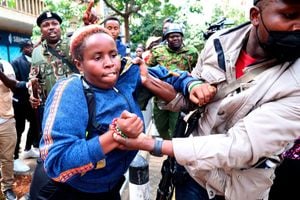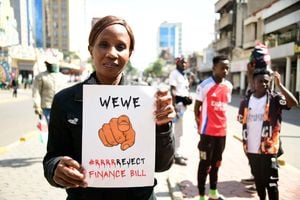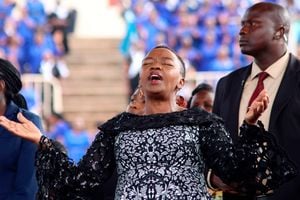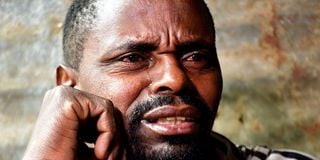
James Wamtitu is overcome with emotions on June 28, 2024 as he tells how his colleague was shot and died on Tuesday evening following the aftermath of the anti-finance protests which took place around Githurai along the Thika Superhighway.
Pandemonium ensued. People fled into nearby shops. Mothers and children ran up and down the street. Some hid in toilets. Screams rang out as the protesters, under the shadow of darkness, called on the police to stop the shooting.
Mr James Wamtitu, who was caught in the ensuing melee, said the situation became chaotic and he parted company with his long-time friend, identified as Mcoast, around 7 pm. As he went to sleep on a bus where he usually sleeps, he heard the gunshots in the air and just prayed for the best.
It was not until the following morning, Wednesday, that reality set in.
"They woke me up from the bus at 4 am and asked me where he (Mcoast) was because we were supposed to do a squad in the morning. They then took me to the nearby shop where I saw his body lying in a pool of blood. I was so heartbroken," said Mr Wamtitu.
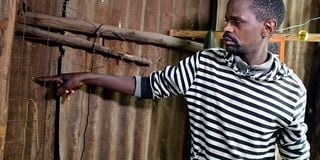
James Wamtitu points at a bullet hole in a shop at Githurai bus stop along the Thika Superhighway on June 28, 2024, where his colleague was shot and killed on Tuesday night in the aftermath of anti-finance protests around Githurai.
Grief following the death of a loved one can take many forms. For Mr Wamtitu, the death of his best friend robbed him of a loved one.
"He was my brother, we stay here and we sleep here on the stage. We shared everything, no matter how small it was. Since then I have never got my life back together and I am unable to work," he said.
As demonstrators marched home after protesting in the capital Nairobi late on Tuesday, June 25, residents of Githurai 45 were dodging bullets from police officers stationed on the flyover. It was a situation never before seen in the area, according to witnesses.
"There was chaos everywhere near the dam area. Some people were hiding in the market and some were shot and ran to the market to hide. The road was impassable," Martin Njeri, a bodaboda rider, told Nation.Africa.
A video circulating on social media showed people running in all directions, scampering for safety amid the sounds of gunfire.
But what really happened?
First, the police story.
A police signal said about 6,000 protesters, who were initially peaceful, started becoming violent at around 10am, and officers from Kasarani and Githurai sub counties responded, and attempts to get the crowd to retreat was futile.
“Tear gas was fired to disperse them but they but they overpowered the officers. And the officers withdrew. As they were withdrawing they blocked the road with an electric pole and consequently cut off Githurai-Mwiki Land Cruiser GKA 601L from the convoy and completely burned it down and vandalized its remains,” the police signal read.
Another two vehicles had their windscreens and mirrors smashed, the police said.
“As the officers were retreating the rioters followed them to Githurai Mwiki Police Station. They wanted to overrun the station but they were overpowered and they retreated,” the police signal went on.
In the melee, the police said, 20 officers were injured and were rushed to hospital and “are in fair condition.”
In the response, the police said they fired 740 blank bullets, 18 rounds of live bullets and 958 pieces of teargas canisters were used.
Law Society of Kenya President Faith Odhiambo has demanded an independent investigation into what happened on that Tuesday, June 25 in Githurai.
“We call upon the international community to conduct independent investigations on the massacre meted out to the residents of Githurai, Nairobi, on the night of June 25, 2024. I dare ask, is Githurai a protected area? Is Githurai an area where members of the public should not stay, should not live? Why was there a massacre where people are living peacefully? We demand answers to those questions,” she told the press in a news conference in Nairobi on Wednesday.
She added: "On social media, people are saying that over 100 people were killed on Tuesday. So we cannot allow those lives to go uncounted and the people who caused those deaths to be held to account."
The Police Reform Working Group, a coalition of organisations campaigning for better policing, said gunshots were heard on Tuesday and that some people had been shot up to 40 times.
The Kenya National Commission on Human Rights, the constitutionally mandated state human rights body, said on Friday that its confirmed death toll related to this week's protests remained at 23, including 19 in Nairobi during Tuesday's actual protests, but did not specify how many of those were from Githurai.
In Githurai, witnesses said a group of military officers coming from the Nairobi CBD tried to clear the road around the flyover, but the youths refused by throwing stones. The shooting then broke out.
At Nairobi's City Mortuary on Wednesday, families and relatives arrived to view the bodies of those killed in the ongoing protests.
A middle-aged man from Githurai said he had come to City Mortuary to find his 21-year-old son, who was among the protesters. He also claimed to have seen a total of six bodies on the Githurai flyover.
"I do not want to believe that he is gone. Maybe he is with a friend and will come back home eventually. I have been looking for him everywhere and he is nowhere to be seen," he said.
Residents of Githurai 45 remained reluctant to come out and talk about Tuesday's events for fear of victimisation. However, several said they knew some people had been killed but could not give a specific number.
Ms Njoki Gachanja, an activist with the Social Justice Association, who was in Githurai on Wednesday, said the association was still trying to get a grip on what was happening in the area.
"We are working with the local communities and there are some people who claim that their relatives are missing. We are yet to reach the families to understand the situation better," said Ms Gachanja.

